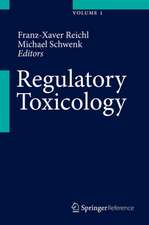The Challenge of CMC Regulatory Compliance for Biopharmaceuticals
Autor John Geigerten Limba Engleză Hardback – 30 dec 2003
| Toate formatele și edițiile | Preț | Express |
|---|---|---|
| Paperback (3) | 698.42 lei 38-44 zile | |
| Springer Nature Switzerland – 16 iun 2024 | 698.42 lei 38-44 zile | |
| Springer – 23 aug 2016 | 1333.49 lei 6-8 săpt. | |
| Springer Us – 24 sep 2012 | 1417.17 lei 6-8 săpt. | |
| Hardback (3) | 1129.02 lei 6-8 săpt. | |
| Springer Nature Switzerland – 16 iun 2023 | 1129.02 lei 6-8 săpt. | |
| Springer Us – 30 dec 2003 | 1426.71 lei 6-8 săpt. | |
| Springer – 7 mai 2013 | 1848.07 lei 6-8 săpt. |
Preț: 1426.71 lei
Preț vechi: 1501.79 lei
-5% Nou
Puncte Express: 2140
Preț estimativ în valută:
273.03€ • 296.47$ • 229.35£
273.03€ • 296.47$ • 229.35£
Carte tipărită la comandă
Livrare economică 23 aprilie-07 mai
Preluare comenzi: 021 569.72.76
Specificații
ISBN-13: 9780306480409
ISBN-10: 0306480409
Pagini: 350
Ilustrații: XXIV, 350 p.
Dimensiuni: 178 x 254 x 30 mm
Greutate: 0.84 kg
Ediția:2004
Editura: Springer Us
Colecția Springer
Locul publicării:New York, NY, United States
ISBN-10: 0306480409
Pagini: 350
Ilustrații: XXIV, 350 p.
Dimensiuni: 178 x 254 x 30 mm
Greutate: 0.84 kg
Ediția:2004
Editura: Springer Us
Colecția Springer
Locul publicării:New York, NY, United States
Public țintă
ResearchDescriere
"The greater our knowledge increases, the more our ignorance unfolds. " U. S. President John F. Kennedy, speech, Rice University, September 12, 1962 My primary purpose for writing this book was much more than to provide another information source on Chemistry, Manufacturing & Controls (CMC) that would rapidly become out of date. My primary purpose was to provide insight and practical suggestions into a common sense business approach to manage the CMC regulatory compliance requirements for biopharmaceuticals. Such a common sense business approach would need (1) to be applicable for all types of biopharmaceutical products both present and future, (2) to address the needs of a biopharmaceutical manufacturer from the beginning to the end of the clinical development stages and including post market approval, and (3) to be adaptable to the constantly changing CMC regulatory compliance requirements and guidance. Trying to accomplish this task was a humbling experience for this author! In Chapter 1, the CMC regulatory process is explained, the breadth of products included under the umbrella ofbiopharmaceuticals are identified, and the track record for the pharmaceutical and biopharmaceutical industry in meeting CMC regulatory compliance is discussed. In Chapter 2, while there are many CMC commonalities between biopharmaceuticals and chemically-synthesized pharmaceuticals, the significant differences in the way the regulatory agencies handle them are examined and the reasons for why such differences are necessary is discussed. Also, the importance of CMC FDA is stressed.
Cuprins
1 Biopharmaceutical CMC Regulatory Compliance: What is It?.- 1. Defining Our Terms.- 1.1. What is a ‘Biopharmaceutical’.- 1.2. What is ‘CMC’.- 1.3. What is ‘CMC Regulatory Compliance’.- 2. Under the Biopharmaceutical Umbrella.- 2.1. Recombinant DNA-Derived Proteins.- 2.2. Monoclonal Antibodies.- 2.3. Gene Therapy.- 2.4. Animal/Plant Transgenics.- 2.5. Rapid Pace of Biopharmaceutical Development.- 3. Regulatory Development of Biopharmaceuticals.- 3.1. The Drug Development Process.- 3.2. Regulatory Agency Review.- 3.2.1. U.S. FDA.- 3.2.2. EMEA.- 4. CMC Regulatory Compliance Track Record.- 4.1. Drugs and Biologics.- 4.2. Biopharmaceuticals.- 2 Are Biopharmaceuticals Really Different?.- 1. Perception or Reality.- 1.1. Five Questions Frequently Asked.- 1.2. Bottom Line Question.- 2. Regulatory Agencies Speak.- 2.1. U.S. FDA.- 2.2. EMEA.- 2.3. ICH.- 3. Three Unique CMC Challenges for Biopharmaceuticals.- 3.1. The Use of Living Recombinant Organisms.- 3.2. The Products Themselves.- 3.3. The Impact of the Manufacturing Process.- 4. CMC Meetings with the FDA Take on Greater Importance.- 4.1. CMC Communication with FDA is Critical.- 4.2. Preparing for the CMC Meeting.- 4.3. Pre-IND Meeting.- 4.4. End of Phase 2 (EOP2) Meeting.- 4.3. Pre-BLA/NDA Meeting.- 5. What About CMC Meetings with Emea.- 6. Biopharmaceuticals Need to be Treated Differently.- 3 Developing the Corporate CMC Regulatory Compliance Strateg.- 1. Three Key Elements for a Complete CMC Strategy.- 1.1. Element 1: The Broad CMC Scope Must Be Considered.- 1.2. Element 2: Any Unique CMC Issues Must Be Addressed.- 1.3. Element 3: Must Meet Minimum CMC Regulatory Requirements.- 2. The Minimum CMC Continuum.- 3. Minimum CMC Requirements for Clinical Development.- 3.1. An Overview.- 3.2. Phase 1.- 3.3. Phase 2 and 3.- 4. Full Cmc Requirements For Dossier Filing.- 4.1. Comparison of BLA/NDA and CTD CMC Formats.- 4.2. Adequate Resources Required to Compile the Full CMC Dossier.- 4.3. Quality of CMC Content Present in Dossier is Critical.- 5. ‘Case-by-Case’ CMC Strategy Specifics.- 4 Can’t Ignore cGMP.- 1. Not Optional.- 1.1 What are ‘cGMPs’.- 1.2 Three main GMP questions.- 2. GMPS for Everything.- 2.1. For Finished Drug Products.- 2.2. Required for APIs Also.- 2.3. Extra GMPs for Biopharmaceuticals.- 3. Where in the Manufacturing Process Should GMP Begin.- 4. When During Clinical Development Should GMP Begin.- 4.1. API Clinical Trial Materials.- 4.2. Drug Product Clinical Trial Materials.- 5. Consequences of not Following GMPS.- 5.1. Issues with Market Approved Biopharmaceuticals.- 5.2. Issues During Clinical Development.- 5.3. How to Avoid GMP Difficulties with the FDA.- 6. Strategic CMC Tips for GMP Compliance.- 5 Recombinant Source Material: Master/Working Bank.- 1. Needed: Reliable, Continuous, Stable Genetic Source.- 1.1. Three Primary CMC Concerns for Banks.- 1.2. Genetic Construction of a Bank.- 2. So Many Hosts to Choose From.- 2.1. Bank Terminology.- 2.2. Choosing the Host.- 2.2.1. Drivers to Reach a Decision.- 2.2.2. Why Choose Recombinant Cells.- 2.2.3. Why Bioengineered Animals or Plants.- 3. CMC Guidance on Preparation of a Bank.- 3.1. Accurate and Thorough Description of Preparation.- 3.1.1. Recombinant Cell Banks.- 3.1.2. Transgenic Banks.- 3.2. Why Does The FDA Want So Much CMC Documentation.- 3.3. When is Full CMC Documentation Needed.- 3.4. What If CMC Documentation is Missing.- 3.5. Don’t forget GMPs During Preparation of the Bank.- 4. CMC Guidance on Characterization of a Bank.- 4.1. Appropriate and Sufficient Characterization.- 4.1.1. Six Key Elements for a Thorough Characterization.- 4.1.2. Recombinant Cell Bank Characterization.- 4.1.3. Example of Characterization of a Bacterial Cell Bank.- 4.1.4. Example of Characterization of a Mammalian Cell Bank.- 4.2. How Much Characterization and When.- 4.3. Critical Concern for Virus Safety in Banks.- 4.4. Minimizing the Risk of TSEs.- 5. A Successful CMC Strategy for Banks.- 6 Production: Expansion of the Recombinant Organism and Expression of the Biopharmaceutica.- 1. Goals: Identity, Capacity and Consistency.- 1.1. Two Major CMC Regulatory Concerns for Production.- 1.2. Need for High and Consistent Expression of the Biopharmaceutical.- 1.3. What is a ‘Production Process’.- 1.3.1. Types of Bioreactors for Cell-Based Production.- 1.3.2. Harvesting Procedures for Biopharmaceuticals.- 1.4. Production Processes Familiar to the FDA.- 2. Adequate Description of the Production Process.- 2.1. During Clinical Development.- 2.1.1. Phase 1 IND Submission.- 2.1.2. Phase 2 IND Submission.- 2.1.3. Phase 3 IND Submission.- 2.2. Preparing the BLA/NDA Submission.- 3. Validation of a Cell-Based Production Process.- 3.1. When Should Validation of the Production Process Occur.- 3.2. Five Major Areas Involved in Validation of the Production Process.- 3.2.1. The Production Facility, Utilities and Process Equipment.- 3.2.2. Monitoring of Growth Parameters.- 3.2.3. In-Process Controls.- 3.2.4. Genetic Stability.- 3.2.5. Cleaning Validation.- 3.3. Final Comments on Process Validation.- 4. Additional Production Controls and Concerns.- 4.1. Cell-Based Production Processes.- 4.1.1. Cell Culture Media Acceptance Criteria.- 4.1.2. Avoidance of Animal- and Human-Derived Raw Materials.- 4.1.3. Containment of the Recombinant Organism.- 4.1.4. Contamination Control for Aseptic Processing Operations.- 4.2. Gene Therapy Production Processes.- 4.2.1. Control of the Cells.- 4.2.2. RAC Review and Approval of the Production Process.- 4.3. Transgenic Animal Production Processes.- 4.3.1. Production Controls.- 4.3.2. Protecting the Gene Pool.- 4.4. Transgenic Plant Production Processes.- 4.4.1. ‘Pharming’ Controls.- 4.4.2. USDA/APHIS Protecting the Gene Pool.- 5. What Can Go Wrong.- 6. Strategic CMC Tips For Production.- 7 Purification of the Biopharmaceutical.- 1. Goals: Purity, Recovery and Consistency.- 1.1. Two Major CMC Regulatory Concerns for Purification.- 1.2. Need for High Recovery of a Pure Product.- 1.3. What is a ‘Purification Process’.- 1.3.1. Physical Separations Methods for Biopharmaceuticals.- 1.3.2. Chromatographic Purification Methods for Biopharmaceuticals.- 1.4. Purification Processes Familiar to the FDA.- 2. Adequate Description of the Purification Process.- 2.1. During Clinical Development.- 2.1.1. Phase 1 IND Submission.- 2.1.2. Phase 2 IND Submission.- 2.1.3. Phase 3 IND Submission.- 2.2. Preparing the BLA/NDA Submission.- 3. Facility and Utility Concerns.- 3.1. Design and Operation.- 3.2. Environmental Monitoring.- 4. Purification Process Validation.- 4.1. When Should Purification Validation Occur.- 4.2. Process Validation Concerns for a Chromatographic Step.- 4.3. Process Validation Concerns for a Filtration Step.- 5. In-Process Controls.- 6. Process-Related Impurity Profile.- 7. Viral Safety Evaluation.- 7.1. General Study Design.- 7.2. Justification of the Choice of Viruses.- 7.3. Calculation of Virus Reduction Factors.- 7.4. Virus Safety Calculation.- 7.5. Worth All the Trouble and Cost.- 7.6. When Should the Viral Clearance Studies Be Performed.- 8. Purification Controls for Gene Therapy Processes.- 9. What Can Go Wrong.- 8 Biopharmaceutical Drug Product Manufacturing.- 1. Three Basic CMC Regulatory Concerns.- 2. Formulation of a Biopharmaceutical.- 2.2. Formulations Familiar to FDA.- 2.3. Chemcial Modification of API Prior to Formulation.- 3. Biopharmaceutial Manufacturing Processes.- 4. Adequate Description of the Manufacturing Process.- 4.1. During Clinical Development.- 4.1.1. Phase 1 IND Submission.- 4.1.2. Phase 2 IND Submission.- 4.1.3. Phase 3 IND Submission.- 4.2. BLA/NDA Submission.- 5. Adequate Control Over the Manufacturing Process.- 5.1. Regulatory Requirements for Market Approved Products.- 5.2. Regulatory Expectations During Clinical Development.- 6. What Can Go Wrong.- 7. Strategic CMC Tips for Drug Product Manufacturing.- 9 Physicochemical/Biological Analysis of the Biopharmaceutical Produc.- 1. A Challenging Analysis.- 1.1. Goals: Consistent, Safe, Potent and Pure Product.- 1.2. Relationship Between Product Characterization and QC Testing.- 2. Unraveling the Molecular Properties.- 2.1. Molecular Variants for DNA.- 2.2. Molecular Variants for Proteins.- 2.3. Plethora of Analytical Methods Available For Proteins.- 3. Characterization of Biopharmaceuticals.- 3.1. Regulatory Expectations During Clinical Development.- 3.1.1. Phase 1 IND Submission.- 3.1.2. Phase 2 IND Submission.- 3.1.3. Phase 3 IND Submission.- 3.2 Regulatory Expectations for the BLA/NDA Submission.- 3.3. Full Characterization of Recombinant Proteins and Monoclonal Antibodies.- 3.3.1. What is ‘Full’ Characterization.- 3.3.2. Host-Dependent Glycosylation.- 3.3.3. Host-Dependent Impurities.- 3.3.4. Impact of Molecular Variants on Biological Activity.- 3.4. Characterization of a Gene Therapy Biopharmaceutical.- 3.5. Applying the Minimum CMC Continuum to Characterization.- 4. Release Testing and Specifications.- 4.1. Regulatory Expectations During Clinical Development.- 4.1.1. Phase 1 IND Submission.- 4.1.2. Phase 2 IND Submission.- 4.1.3. Phase 3 IND Submission.- 4.2. Regulatory Expectations for the BLA/NDA Submission.- 4.3. Appropriate Release Test Methods.- 4.3.1. Not All Release Testing is at API or Drug Product Stage.- 4.3.2. Elimination of Release Testing by Process Validation.- 4.3.3. Test Method Parameters Required for Release: Proteins.- 4.3.4. Test Method Parameters Required for Release: DNA Vectors.- 4.4. The Bioassay — Absolute Requirement for a Biopharmaceutical.- 4.5. Test Method Validation — How Much and When.- 4.5.1. Regulatory Expectations for Test Method Validation.- 4.5.2. Assay Qualification During Clinical Development.- 4.5.3. Applying the Minimum CMC Continuum to Test Method Validation.- 4.6. The Art of Setting a Specification.- 4.6.1. Development of a Specification.- 4.6.2. Release Versus Shelf-Life Specifications.- 4.6.3. Are There Required Purity/Impurity Limits.- 4.6.4. Strategic CMC Tips for Setting Specifications.- 5. Biopharmaceutical Stability and Expiration Dating.- 5.1. Regulatory Expectations During Clinical Development.- 5.1.1. Phase 1 IND Submission.- 5.1.2. Phase 2 IND Submission.- 5.1.3. Phase 3 IND Submission.- 5.2. Regulatory Expectations for the BLA/NDA Submission.- 5.3. Stability-Indicating Test Methods.- 5.4. Setting an Expiration Date.- 5.5. How Much Change is Acceptable.- 5.6. Applying the Minimum CMC Continuum to Stability.- 6. What Can Go Wrong.- 6.1. Incomplete Release/Stability Testing Requirements in BLA/NDA Filing.- 6.2. FDA 483 Inspectional Observations.- 6.3. Biopharmaceutical Product Recalls.- 6.4. Misuse in the Clinic.- 7. Strategic Cmc Tips For Biopharmaceutical Analysis.- 10 Managing Process Changes — Demonstrating Product Comparabilit.- 1. Not As Easy as it Seems.- 2. Regulatory Management of Process Changes.- 2.1. Pre-IND Stage.- 2.2. IND Clinical Development Stages.- 2.3. BLA/NDA Filing Stage.- 2.4. Post-Approval Market Stage.- 3. Demonstrating Product Comparability.- 3.1 Guidance Documents on Product Comparability.- 3.2. A Three-Tiered Testing Hierarchy.- 3.3. Designing the Comparability Study — Four Major Factors.- 3.3.1. Factor 1: Clinical Development Stage for the Change.- 3.3.2. Factor 2: Where in the Process the Change is Introduced.- 3.3.3. Factor 3: Quality Criteria Considerations.- 3.3.4. Factor 4: Suitability of Available Analytical Methods.- 3.4. Regulatory Agencies Have Final Approval.- 3.5 If in Doubt, Ask.- 4. Comparability Protocols.- 5. Case Examples of Biopharmaceutical Comparability.- 5.1. Comparability Success Stories.- 5.2. Comparability Surprises.- 5.3. Not Comparable.- 11 Biopharmaceutical CMC Outsourcing.- 1. Regulatory Expectations for Contracted Works.- 1.1. Why Outsource.- 1.2. Written Quality Agreements Required.- 1.3. Regulatory Requirements During Clinical Development.- 1.4. Regulatory Requirements for the BLA/NDA Submission.- 1.5. Regulatory Requirements Post-Market Approval.- 2. Developing the Intercompany Quality Agreement.- 2.1. Two Viewpoints.- 2.1.1. The Biopharmaceutical Company Seeking to Outsource.- 2.1.2. The Contact Manufacturer Offering Outsourcing.- 2.1.3. Maximum Leverage.- 2.2. Contents of an IQA.- 3. Strategic CMC Tips for Outsourcing.- 12 Concluding Thoughts on Biopharmaceutical CMC Regulatory Compliance.- 1. Most Helpful Websites for Biopharmaceuticals.- 2. Website Resources from FDA.- 3. Resources from Emea.- 4. Resources from Professional Associations.- 5. Conclusion.- References.
Notă biografică
John Geigert, Ph.D., RAC is President of BioPharmaceutical Quality Solutions, in San Diego, California. He has over 40 years of experience within the biopharmaceutical industry developing Chemistry, Manufacturing & Controls (CMC) regulatory compliant strategies for recombinant proteins, monoclonal antibodies, biosimilars, gene therapy vectors, and cell‐based medicines. Dr. Geigert has 10 years Executive Management experience as Vice President, Quality & Executive Officer at IDEC Pharmaceuticals, and Vice President, Quality at Immunex. He now has served for 20 years as an international independent CMC regulatory compliance consultant. He is a past chair of the PDA Biopharmaceutical Advisory Board. Dr. Geigert is also the author of the book, The Challenge of CMC Regulatory Compliance for Biopharmaceuticals 3rd Edition (May 2019).
Textul de pe ultima copertă
An effective CMC regulatory compliance strategy for biologics and biopharmaceuticals can seem like a mystery. Through means of this 2nd edition, this no longer needs to occur. A great deal of thanks goes to two regulatory authorities – the United States Food and Drug Administration (FDA) and the European Medicines Agency (EMA), who provide through their respective websites, an abundance of guidance, especially in the last several years. So much has changed since the 1st edition of this book was published in 2004. There are now additional manufacturing processes for producing commercial biopharmaceuticals – transgenic plant cell cultures and transgenic animals. In addition to commercial recombinant proteins and monoclonal antibodies, there are now commercial cell-based medicines (cellular therapy) and DNA-based medicines (gene therapy). Biosimilars are now on the marketplace in Europe, and under review for commercial approval in the USA. Vaccine manufacturing has resurged due to the concerns of potentially pandemic mutated animal influenzas (e.g., swine flu, bird flu). Strategic international regulatory guidances have been adopted that are driving the entire pharmaceutical industry, including biopharmaceuticals, to a higher standard of performance, including Quality by Design (QbD), Quality Risk Management (QRM) and Pharmaceutical Quality Systems (PQS). The vast majority of the over 600 regulatory references listed in this book were either issued or updated since the release of the 1st edition. All of these changes are the reason this updated edition includes not only biopharmaceuticals but also other biologics (e.g., live virus vaccines, human plasma-derived proteins, cell-based medicines, natural-sourced proteins) that have CMC regulatory compliance concerns and challenges in common with the genetically-engineered biologics (i.e., the biopharmaceuticals).
About The Author
John Geigert is President of BioPharmaceutical Quality Solutions, which specializes in providing CMC regulatory strategy consulting for the biopharmaceutical and biologic industry. Dr. Geigert has over 35 years of CMC industrial experience and leadership in the biopharmaceutical industry. Dr. Geigert has served on the PDA Board of Directors, co-chaired the PDA Biotech Advisory Board and served as an expert member of the USP Biotechnology Committee. Dr. Geigert has written extensively for the Regulatory Affairs Professional Society (RAPS) Focus (What Senior Management Needs to Know About CMC Regulatory Compliance for Biotech Products (Aug-Nov 2009, 4-part series) and Demystifying CMC Regulatory Strategy (Sept 2011-Mar 2012, 4-part series)).
About The Author
John Geigert is President of BioPharmaceutical Quality Solutions, which specializes in providing CMC regulatory strategy consulting for the biopharmaceutical and biologic industry. Dr. Geigert has over 35 years of CMC industrial experience and leadership in the biopharmaceutical industry. Dr. Geigert has served on the PDA Board of Directors, co-chaired the PDA Biotech Advisory Board and served as an expert member of the USP Biotechnology Committee. Dr. Geigert has written extensively for the Regulatory Affairs Professional Society (RAPS) Focus (What Senior Management Needs to Know About CMC Regulatory Compliance for Biotech Products (Aug-Nov 2009, 4-part series) and Demystifying CMC Regulatory Strategy (Sept 2011-Mar 2012, 4-part series)).
Caracteristici
Highlights the challenges facing quality assurance/quality control (QA/QC) in today's biopharmaceutical environment
Presents the strategic importance and value generated by QA/QC for their involvement in control of manufacturing
Revised 2nd Edition is broadened to include biopharmaceuticals (biotech drugs) and other biologics (vaccines, cell therapy, plasma-derived proteins, etc.)
Includes supplementary material: sn.pub/extras
Presents the strategic importance and value generated by QA/QC for their involvement in control of manufacturing
Revised 2nd Edition is broadened to include biopharmaceuticals (biotech drugs) and other biologics (vaccines, cell therapy, plasma-derived proteins, etc.)
Includes supplementary material: sn.pub/extras





















